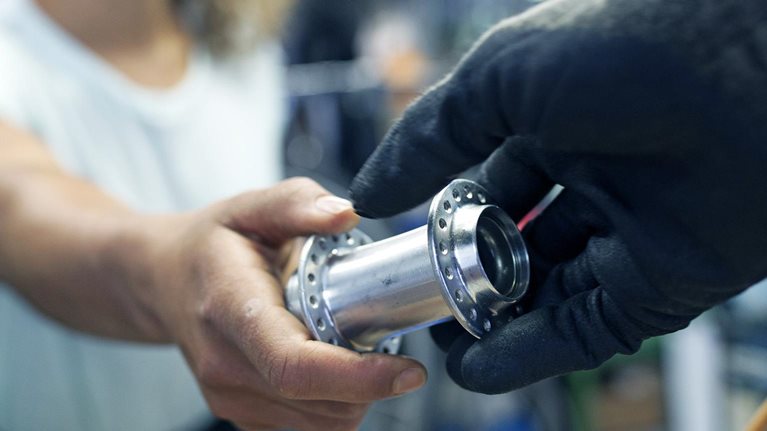As the quest for solutions to tackle the climate impact of aviation becomes more urgent, there is great interest in alternative-propulsion technologies, such as hydrogen-, battery-electric-, and hybrid-electric-powered aircraft. Aircraft running on hydrogen and battery-electric powertrains could make up 21 to 38 percent of the global commercial and cargo aircraft fleet by 2050, based on Mission Possible Partnership’s energy estimates for the aviation sector.1 While the timelines may feel distant, the new technologies will begin appearing in this decade.
There is uncertainty about what these infrastructure changes entail and how airports and other stakeholders can begin to prepare for them. Target True Zero: Delivering the infrastructure for battery and hydrogen-powered flight is a report produced by Target True Zero—a World Economic Forum initiative that brings together leaders from across the aerospace and aviation industries—with support from knowledge partners Aviation Environment Federation, McKinsey, and the University of Cambridge’s Aviation Impact Accelerator. It is intended to help shine a light on some of the key considerations affecting alternative propulsion.
The report has three objectives:
- Identify the energy and infrastructure requirements for alternative propulsion to meet 2050 goals at both the global and airport levels.
- Explore what the requirements mean for the level and timing of investments.
- Provide insight on the coordination required to deliver appropriate infrastructure within the aviation sector, sometimes in partnership with other sectors, to meet the goals.
The report’s findings, summarized here, are built on ten key insights developed through McKinsey analysis and informed by conversations with industry leaders and workshops held by Target True Zero.
Infrastructure for the shift to alternative production
Demand for clean energy in aviation could soar to new heights. We estimated the demand for the energy required to support aircraft using alternative propulsion in 2050 and then examined the implications for aviation infrastructure.
Large amount of clean energy needed to meet demand
Battery-electric- and hydrogen-powered aircraft could make up between 21 and 38 percent of all aircraft by 2050, representing 15 to 34 percent of the sector’s overall energy needs. Alternative propulsion could require between 600 and 1,700 terrawatt-hours of clean energy by 2050, globally, which is equivalent to the energy generated by around ten to 25 of the world’s largest wind farms or a solar farm the size of Belgium. About 89 to 96 percent of the energy would be used for hydrogen-powered aircraft, while only 4 to 11 percent would be used to power smaller battery-electric-powered aircraft, such as turboprops, regional jets, and smaller narrow-body aircraft (Exhibit 1).

Increase in energy consumption by large airports
As alternative propulsion gains ground, airports will need more energy for their on-site operations than they do today. For an airport that is a large hub looking to invest in on-site hydrogen liquefaction and charging for battery-electric-powered aircraft, total on-site electricity consumption for terminals, ground support, and other uses could be between 1,250 and 2,450 gigawatt-hours per year, which is about five to ten times more electricity than London Heathrow currently consumes. To meet these demands, airports will need to take steps to upgrade grid connections, local power distribution infrastructure, and their own power stations.
Two new infrastructure value chains
Alternative propulsion will require two new infrastructure value chains. One will involve battery-electric-powered aviation, and the other will be for hydrogen-powered aviation. These value chains may include many new partners that aren’t currently part of the aviation ecosystem, and they will coexist with the infrastructure required for sustainable aviation fuel and conventional fuel. The sector will need new procedures for energy acquisition, storage, processing, and management, as well as the means to distribute that energy to aircraft.
More space for clean-energy generation
Most airports have space for hydrogen liquefaction and storage infrastructure but not enough land to generate the clean energy needed to power aircraft via battery-electric and hydrogen means. While airports have been touted as possible energy hubs, the scale of energy demand for alternative propulsion will make it extremely difficult to perform all energy production at airports. For instance, if Paris-Charles De Gaulle Airport is used as an example of a major international hub, it would require approximately 5,800 hectares of solar panels to generate sufficient electricity to meet its demands under Mission Possible Partnership’s prudent scenario. This far exceeds the size of the airport itself, which now occupies 3,300 hectares. Given such significant space requirements, most airports will likely rely on partnerships with other electricity providers within their regional ecosystems to meet them.
Investment to fund alternative-propulsion infrastructure
Delivering the necessary on- and off-airport infrastructure needed for alternative propulsion will require significant investment from airports and other stakeholders. Our analysis uncovered multiple insights related to this investment.
Investment for alternative-propulsion value chain
Shifting to alternative propulsion will require a capital investment of between $700 billion and $1.7 trillion across the value chain by 2050 (Exhibit 2). Approximately 90 percent of this investment will be for off-airport infrastructure—primarily power generation and hydrogen electrolysis and liquefaction. Capital expenditures in green-power generation for aviation alone would double the current projections for global airport capital expenditures ($1.68 trillion by 2040, at $84 billion per year). This makes it almost certain that aviation players will need to form partnerships with companies in other industries, such as energy providers and those in hydrogen-consuming industries, to secure the required investment.

On-airport infrastructure capital expenditures, which make up the remaining 10 percent of total capital expenditures, will amount to a more modest $66 billion to $114 billion, in total, by 2050. This represents the equivalent of 0.8 to 1.4 years of incremental investment in airport reconstruction and expansion, based on the current average spending.
Investment for airport infrastructure
The investment needed for airport infrastructure in the shift to alternative propulsion will be significantly higher for large airports than for smaller airports but of similar magnitude to other major investments, such as building a new terminal. An intercontinental hub could expect to invest a total of approximately $3.9 billion by 2050 across the whole value chain, including energy acquisition and hydrogen production, while the investment for a major regional airport would be about $1.3 billion.
Putting this in perspective, the capital expenditures for an international hub or major regional airport would be roughly equivalent to those for the LaGuardia Airport terminal expansion, or about 20 percent of the cost of the Heathrow Airport’s third runway project. The costs for smaller airports will be much lower, as they won’t have to support larger aircraft, which require more advanced infrastructure.
Premiums for green electricity
Operators of alternative propulsion are expected to pay premiums of 76 to 86 percent over the market price for green electricity, reflecting additional aviation infrastructure operating costs. Another important consideration for airports and operators relates to their operational expenditures—particularly the cost of energy since this will determine the extent to which battery-electric- and hydrogen-powered aircraft are adopted. The additional costs to process and deliver hydrogen and electricity to airports will create a premium for using these types of propulsion, similar conceptually to the “crack spread” difference between the pricing for a barrel of crude oil and that for the petroleum products refined from it.
Investments needed now to meet 2050 goals and expected energy demand
The investments needed to meet 2050 alternative-propulsion-related infrastructure goals must start now. The first elements of on-airport infrastructure must be in place by 2025 to meet the expected energy demand. From investment to installation, the development timelines for battery-electric infrastructure could be between two and four years (Exhibit 3). Airports are already connected to power grids and may have electrical ground support equipment and electric-vehicle chargers in place. While grid connection upgrades and energy storage systems are likely to be required as battery-electric-powered aircraft become more popular, battery-electric infrastructure will be relatively easy to scale up.

By contrast, hydrogen infrastructure is much less likely to be incremental. Airports may need to rebuild onsite hydrogen infrastructure as adoption of hydrogen-powered aircraft increases, or they may be able to skip certain steps, based on growth forecasts.
Collaboration to deliver alternative-propulsion infrastructure
The transition to alternative aircraft propulsion is complex and expensive, so airports can’t undertake this work in isolation.
Coordination for infrastructure investment
To harness the power of network effects and regional connectivity, coordination of infrastructure investment will be required to make alternative-propulsion operation feasible. While large airports will bear the highest costs in the switch to alternative propulsion, initial use cases for the fuels will likely involve smaller airports for battery-electric-powered flights or single point-to-point routes between large and midsize airports for aircraft powered by hydrogen. Coordination of investment at smaller airports within smaller geographic regions will therefore be necessary for the operation of battery-electric-powered aircraft. For hydrogen-powered aircraft, coordination among large and small airports—possibly across multiple national jurisdictions—will be needed and therefore represents a bigger challenge. To be successful, airports, operators, and other stakeholders must come together to catalyze action within and across regions.
Partnership for accessing the supply and shaping the future
The aviation industry will need to partner with other industries to secure enough green electricity and hydrogen for alternative propulsion in a supply-constrained environment and to have a voice in the future of the hydrogen ecosystem. Airports could acquire sufficient stores of hydrogen and help shape the future of the industry by exploring partnerships with green-energy suppliers for electricity generation and hydrogen production. They could also link up with high-demand hydrogen consumers, such as refineries and steel and fertilizer manufacturers, and with sustainable-aviation-fuel producers to provide direct-fuel hydrogen to airports. This approach would also enable airports to invest in the development of efficient electrolysis and liquefaction technology, with the goals of reducing cost and bringing production closer to the airport.
The introduction and growth of alternative propulsion within the aviation sector will require significant changes to the current value chains, necessitating huge investment in clean-energy production, airport investment, and coordination across multiple stakeholders within and outside the traditional aviation sector. The first changes may occur soon; however, the significant changes resulting from a shift to alternative propulsion will occur gradually, allowing airports and their constituents to prepare accordingly.


